Sociology Essay: Australian Policies and Indigenous Population
VerifiedAdded on 2023/02/01
|9
|2015
|58
Essay
AI Summary
This sociology essay examines the historical and contemporary relationship between the Australian government and its Indigenous population. The essay begins by outlining key events, including the Commonwealth Franchise Act of 1902 and the 1967 Referendum, analyzing their impact on Indigenous voting rights and citizenship. It explores the evolution of governmental policies, highlighting the shift from marginalization to a more nuanced approach, while also acknowledging the ongoing challenges faced by Indigenous Australians, such as health disparities and educational inequalities. The essay further discusses the connections and differences between Indigenous and non-Indigenous communities, addressing issues of social and cultural norms, racial discrimination, and the efforts made to bridge the gap. The author reproduces knowledge of this history to reinforce contemporary understandings of the issues and concludes with a personal reflection on the effectiveness of government initiatives. The essay draws on various sources to support its arguments, providing a comprehensive overview of the sociological issues surrounding Indigenous Australians.
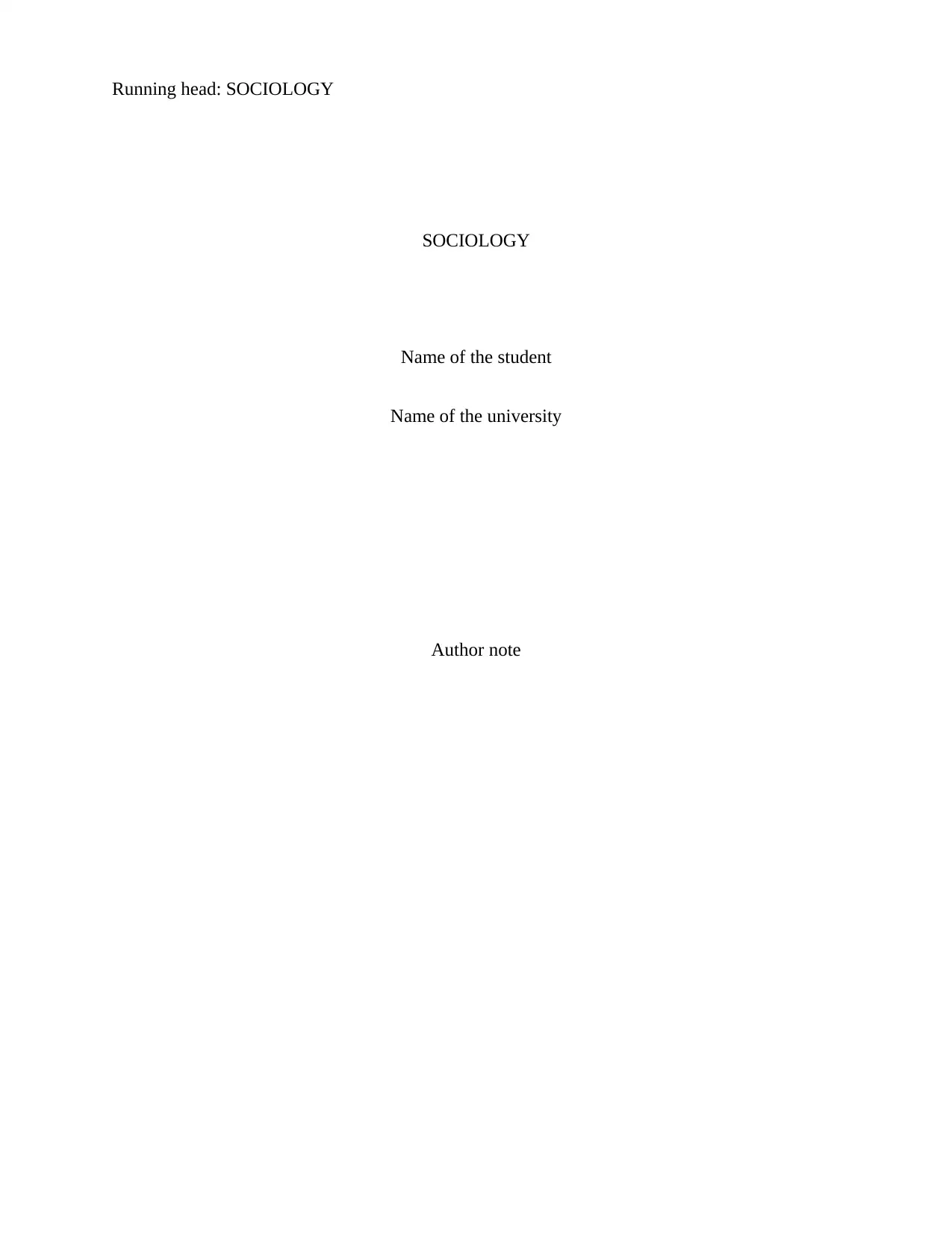
Running head: SOCIOLOGY
SOCIOLOGY
Name of the student
Name of the university
Author note
SOCIOLOGY
Name of the student
Name of the university
Author note
Paraphrase This Document
Need a fresh take? Get an instant paraphrase of this document with our AI Paraphraser
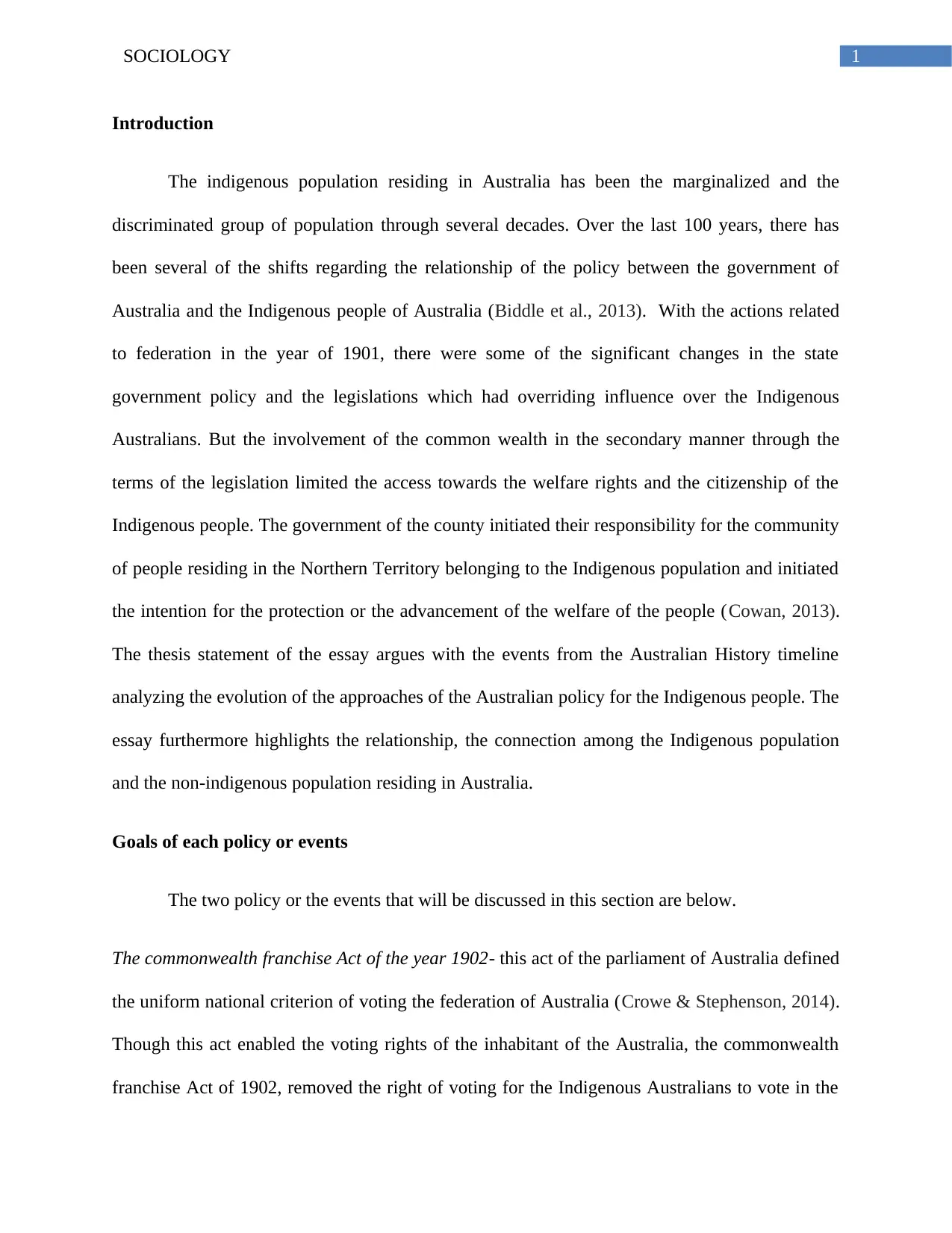
SOCIOLOGY 1
Introduction
The indigenous population residing in Australia has been the marginalized and the
discriminated group of population through several decades. Over the last 100 years, there has
been several of the shifts regarding the relationship of the policy between the government of
Australia and the Indigenous people of Australia (Biddle et al., 2013). With the actions related
to federation in the year of 1901, there were some of the significant changes in the state
government policy and the legislations which had overriding influence over the Indigenous
Australians. But the involvement of the common wealth in the secondary manner through the
terms of the legislation limited the access towards the welfare rights and the citizenship of the
Indigenous people. The government of the county initiated their responsibility for the community
of people residing in the Northern Territory belonging to the Indigenous population and initiated
the intention for the protection or the advancement of the welfare of the people (Cowan, 2013).
The thesis statement of the essay argues with the events from the Australian History timeline
analyzing the evolution of the approaches of the Australian policy for the Indigenous people. The
essay furthermore highlights the relationship, the connection among the Indigenous population
and the non-indigenous population residing in Australia.
Goals of each policy or events
The two policy or the events that will be discussed in this section are below.
The commonwealth franchise Act of the year 1902- this act of the parliament of Australia defined
the uniform national criterion of voting the federation of Australia (Crowe & Stephenson, 2014).
Though this act enabled the voting rights of the inhabitant of the Australia, the commonwealth
franchise Act of 1902, removed the right of voting for the Indigenous Australians to vote in the
Introduction
The indigenous population residing in Australia has been the marginalized and the
discriminated group of population through several decades. Over the last 100 years, there has
been several of the shifts regarding the relationship of the policy between the government of
Australia and the Indigenous people of Australia (Biddle et al., 2013). With the actions related
to federation in the year of 1901, there were some of the significant changes in the state
government policy and the legislations which had overriding influence over the Indigenous
Australians. But the involvement of the common wealth in the secondary manner through the
terms of the legislation limited the access towards the welfare rights and the citizenship of the
Indigenous people. The government of the county initiated their responsibility for the community
of people residing in the Northern Territory belonging to the Indigenous population and initiated
the intention for the protection or the advancement of the welfare of the people (Cowan, 2013).
The thesis statement of the essay argues with the events from the Australian History timeline
analyzing the evolution of the approaches of the Australian policy for the Indigenous people. The
essay furthermore highlights the relationship, the connection among the Indigenous population
and the non-indigenous population residing in Australia.
Goals of each policy or events
The two policy or the events that will be discussed in this section are below.
The commonwealth franchise Act of the year 1902- this act of the parliament of Australia defined
the uniform national criterion of voting the federation of Australia (Crowe & Stephenson, 2014).
Though this act enabled the voting rights of the inhabitant of the Australia, the commonwealth
franchise Act of 1902, removed the right of voting for the Indigenous Australians to vote in the
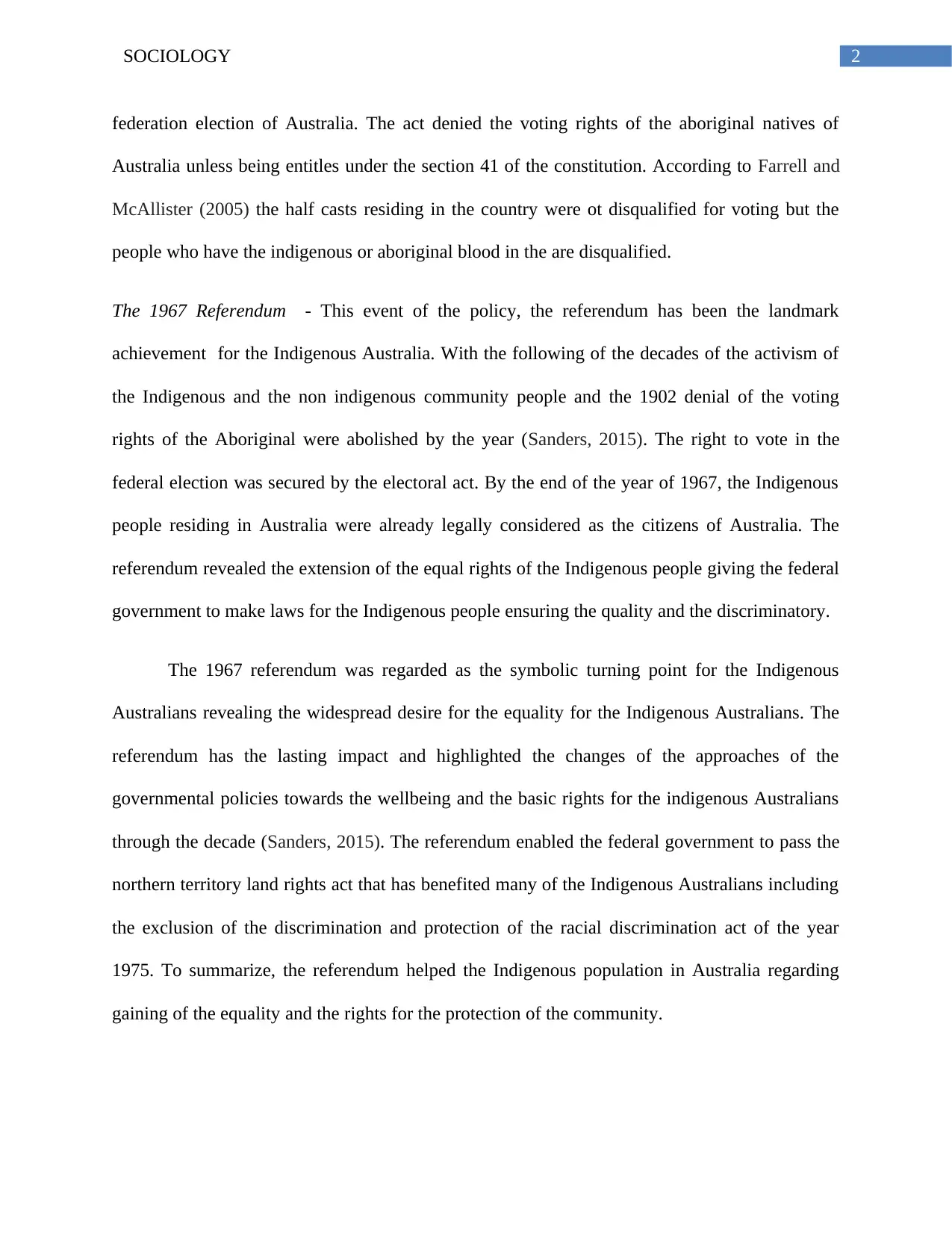
2SOCIOLOGY
federation election of Australia. The act denied the voting rights of the aboriginal natives of
Australia unless being entitles under the section 41 of the constitution. According to Farrell and
McAllister (2005) the half casts residing in the country were ot disqualified for voting but the
people who have the indigenous or aboriginal blood in the are disqualified.
The 1967 Referendum - This event of the policy, the referendum has been the landmark
achievement for the Indigenous Australia. With the following of the decades of the activism of
the Indigenous and the non indigenous community people and the 1902 denial of the voting
rights of the Aboriginal were abolished by the year (Sanders, 2015). The right to vote in the
federal election was secured by the electoral act. By the end of the year of 1967, the Indigenous
people residing in Australia were already legally considered as the citizens of Australia. The
referendum revealed the extension of the equal rights of the Indigenous people giving the federal
government to make laws for the Indigenous people ensuring the quality and the discriminatory.
The 1967 referendum was regarded as the symbolic turning point for the Indigenous
Australians revealing the widespread desire for the equality for the Indigenous Australians. The
referendum has the lasting impact and highlighted the changes of the approaches of the
governmental policies towards the wellbeing and the basic rights for the indigenous Australians
through the decade (Sanders, 2015). The referendum enabled the federal government to pass the
northern territory land rights act that has benefited many of the Indigenous Australians including
the exclusion of the discrimination and protection of the racial discrimination act of the year
1975. To summarize, the referendum helped the Indigenous population in Australia regarding
gaining of the equality and the rights for the protection of the community.
federation election of Australia. The act denied the voting rights of the aboriginal natives of
Australia unless being entitles under the section 41 of the constitution. According to Farrell and
McAllister (2005) the half casts residing in the country were ot disqualified for voting but the
people who have the indigenous or aboriginal blood in the are disqualified.
The 1967 Referendum - This event of the policy, the referendum has been the landmark
achievement for the Indigenous Australia. With the following of the decades of the activism of
the Indigenous and the non indigenous community people and the 1902 denial of the voting
rights of the Aboriginal were abolished by the year (Sanders, 2015). The right to vote in the
federal election was secured by the electoral act. By the end of the year of 1967, the Indigenous
people residing in Australia were already legally considered as the citizens of Australia. The
referendum revealed the extension of the equal rights of the Indigenous people giving the federal
government to make laws for the Indigenous people ensuring the quality and the discriminatory.
The 1967 referendum was regarded as the symbolic turning point for the Indigenous
Australians revealing the widespread desire for the equality for the Indigenous Australians. The
referendum has the lasting impact and highlighted the changes of the approaches of the
governmental policies towards the wellbeing and the basic rights for the indigenous Australians
through the decade (Sanders, 2015). The referendum enabled the federal government to pass the
northern territory land rights act that has benefited many of the Indigenous Australians including
the exclusion of the discrimination and protection of the racial discrimination act of the year
1975. To summarize, the referendum helped the Indigenous population in Australia regarding
gaining of the equality and the rights for the protection of the community.
⊘ This is a preview!⊘
Do you want full access?
Subscribe today to unlock all pages.

Trusted by 1+ million students worldwide
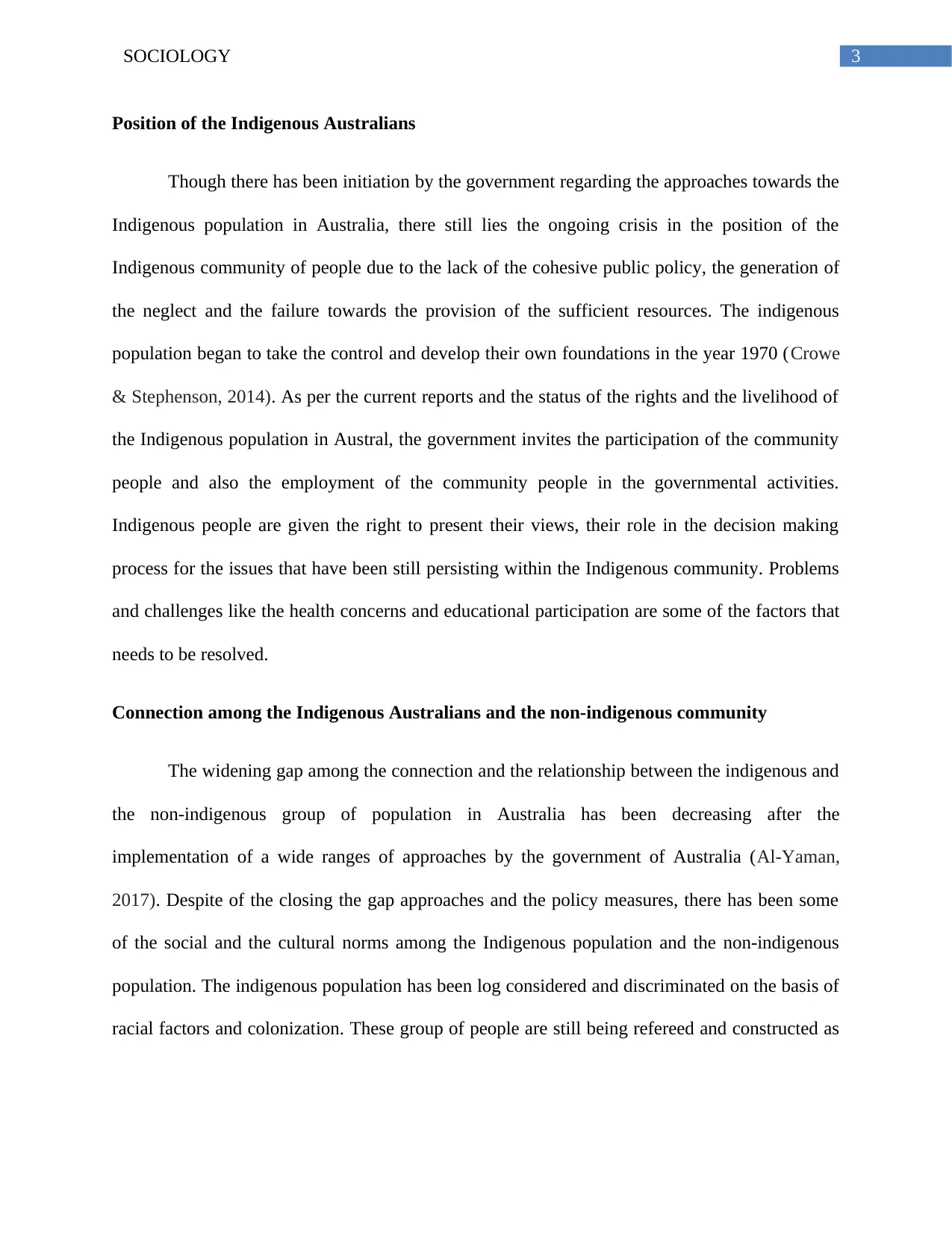
3SOCIOLOGY
Position of the Indigenous Australians
Though there has been initiation by the government regarding the approaches towards the
Indigenous population in Australia, there still lies the ongoing crisis in the position of the
Indigenous community of people due to the lack of the cohesive public policy, the generation of
the neglect and the failure towards the provision of the sufficient resources. The indigenous
population began to take the control and develop their own foundations in the year 1970 (Crowe
& Stephenson, 2014). As per the current reports and the status of the rights and the livelihood of
the Indigenous population in Austral, the government invites the participation of the community
people and also the employment of the community people in the governmental activities.
Indigenous people are given the right to present their views, their role in the decision making
process for the issues that have been still persisting within the Indigenous community. Problems
and challenges like the health concerns and educational participation are some of the factors that
needs to be resolved.
Connection among the Indigenous Australians and the non-indigenous community
The widening gap among the connection and the relationship between the indigenous and
the non-indigenous group of population in Australia has been decreasing after the
implementation of a wide ranges of approaches by the government of Australia (Al-Yaman,
2017). Despite of the closing the gap approaches and the policy measures, there has been some
of the social and the cultural norms among the Indigenous population and the non-indigenous
population. The indigenous population has been log considered and discriminated on the basis of
racial factors and colonization. These group of people are still being refereed and constructed as
Position of the Indigenous Australians
Though there has been initiation by the government regarding the approaches towards the
Indigenous population in Australia, there still lies the ongoing crisis in the position of the
Indigenous community of people due to the lack of the cohesive public policy, the generation of
the neglect and the failure towards the provision of the sufficient resources. The indigenous
population began to take the control and develop their own foundations in the year 1970 (Crowe
& Stephenson, 2014). As per the current reports and the status of the rights and the livelihood of
the Indigenous population in Austral, the government invites the participation of the community
people and also the employment of the community people in the governmental activities.
Indigenous people are given the right to present their views, their role in the decision making
process for the issues that have been still persisting within the Indigenous community. Problems
and challenges like the health concerns and educational participation are some of the factors that
needs to be resolved.
Connection among the Indigenous Australians and the non-indigenous community
The widening gap among the connection and the relationship between the indigenous and
the non-indigenous group of population in Australia has been decreasing after the
implementation of a wide ranges of approaches by the government of Australia (Al-Yaman,
2017). Despite of the closing the gap approaches and the policy measures, there has been some
of the social and the cultural norms among the Indigenous population and the non-indigenous
population. The indigenous population has been log considered and discriminated on the basis of
racial factors and colonization. These group of people are still being refereed and constructed as
Paraphrase This Document
Need a fresh take? Get an instant paraphrase of this document with our AI Paraphraser
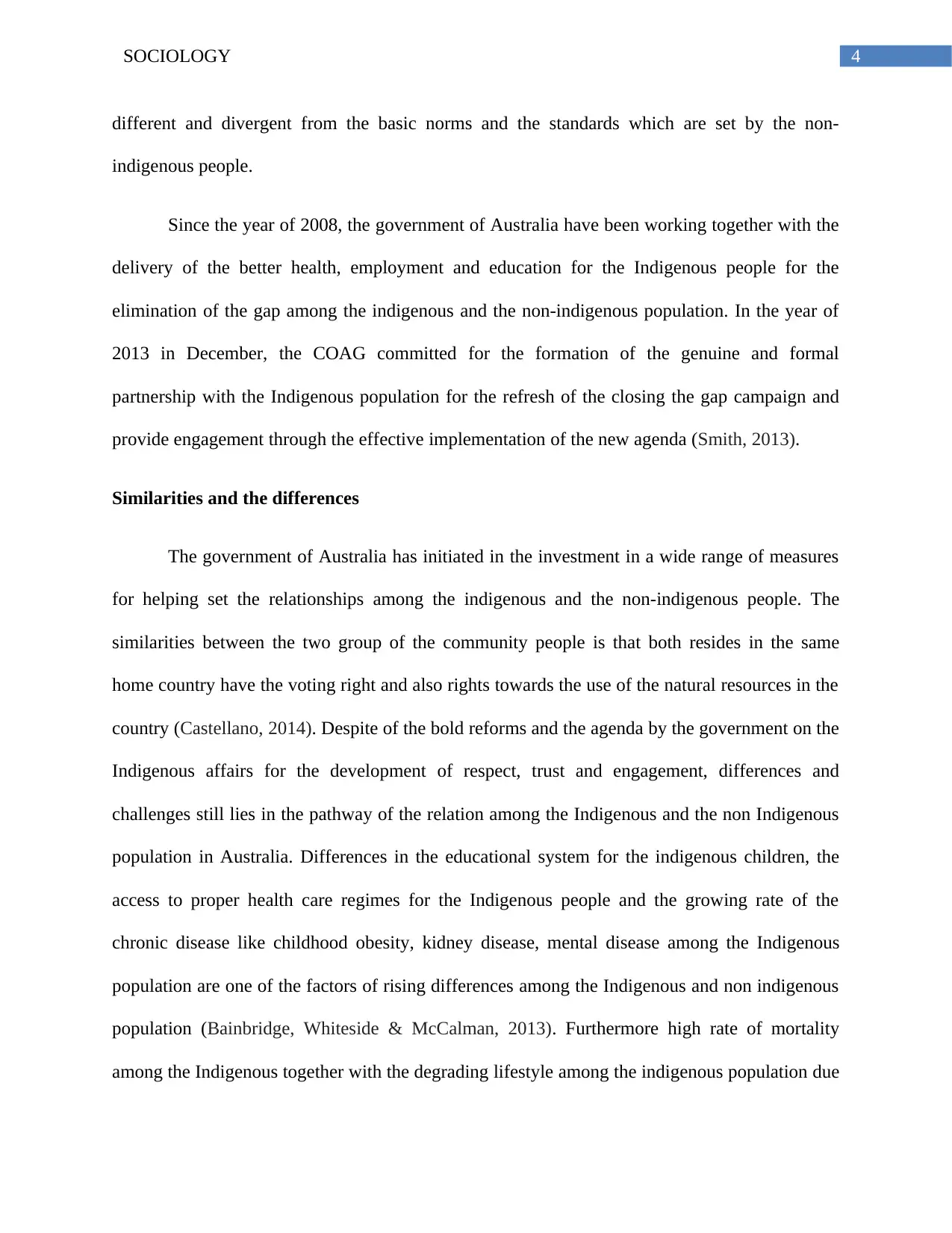
4SOCIOLOGY
different and divergent from the basic norms and the standards which are set by the non-
indigenous people.
Since the year of 2008, the government of Australia have been working together with the
delivery of the better health, employment and education for the Indigenous people for the
elimination of the gap among the indigenous and the non-indigenous population. In the year of
2013 in December, the COAG committed for the formation of the genuine and formal
partnership with the Indigenous population for the refresh of the closing the gap campaign and
provide engagement through the effective implementation of the new agenda (Smith, 2013).
Similarities and the differences
The government of Australia has initiated in the investment in a wide range of measures
for helping set the relationships among the indigenous and the non-indigenous people. The
similarities between the two group of the community people is that both resides in the same
home country have the voting right and also rights towards the use of the natural resources in the
country (Castellano, 2014). Despite of the bold reforms and the agenda by the government on the
Indigenous affairs for the development of respect, trust and engagement, differences and
challenges still lies in the pathway of the relation among the Indigenous and the non Indigenous
population in Australia. Differences in the educational system for the indigenous children, the
access to proper health care regimes for the Indigenous people and the growing rate of the
chronic disease like childhood obesity, kidney disease, mental disease among the Indigenous
population are one of the factors of rising differences among the Indigenous and non indigenous
population (Bainbridge, Whiteside & McCalman, 2013). Furthermore high rate of mortality
among the Indigenous together with the degrading lifestyle among the indigenous population due
different and divergent from the basic norms and the standards which are set by the non-
indigenous people.
Since the year of 2008, the government of Australia have been working together with the
delivery of the better health, employment and education for the Indigenous people for the
elimination of the gap among the indigenous and the non-indigenous population. In the year of
2013 in December, the COAG committed for the formation of the genuine and formal
partnership with the Indigenous population for the refresh of the closing the gap campaign and
provide engagement through the effective implementation of the new agenda (Smith, 2013).
Similarities and the differences
The government of Australia has initiated in the investment in a wide range of measures
for helping set the relationships among the indigenous and the non-indigenous people. The
similarities between the two group of the community people is that both resides in the same
home country have the voting right and also rights towards the use of the natural resources in the
country (Castellano, 2014). Despite of the bold reforms and the agenda by the government on the
Indigenous affairs for the development of respect, trust and engagement, differences and
challenges still lies in the pathway of the relation among the Indigenous and the non Indigenous
population in Australia. Differences in the educational system for the indigenous children, the
access to proper health care regimes for the Indigenous people and the growing rate of the
chronic disease like childhood obesity, kidney disease, mental disease among the Indigenous
population are one of the factors of rising differences among the Indigenous and non indigenous
population (Bainbridge, Whiteside & McCalman, 2013). Furthermore high rate of mortality
among the Indigenous together with the degrading lifestyle among the indigenous population due
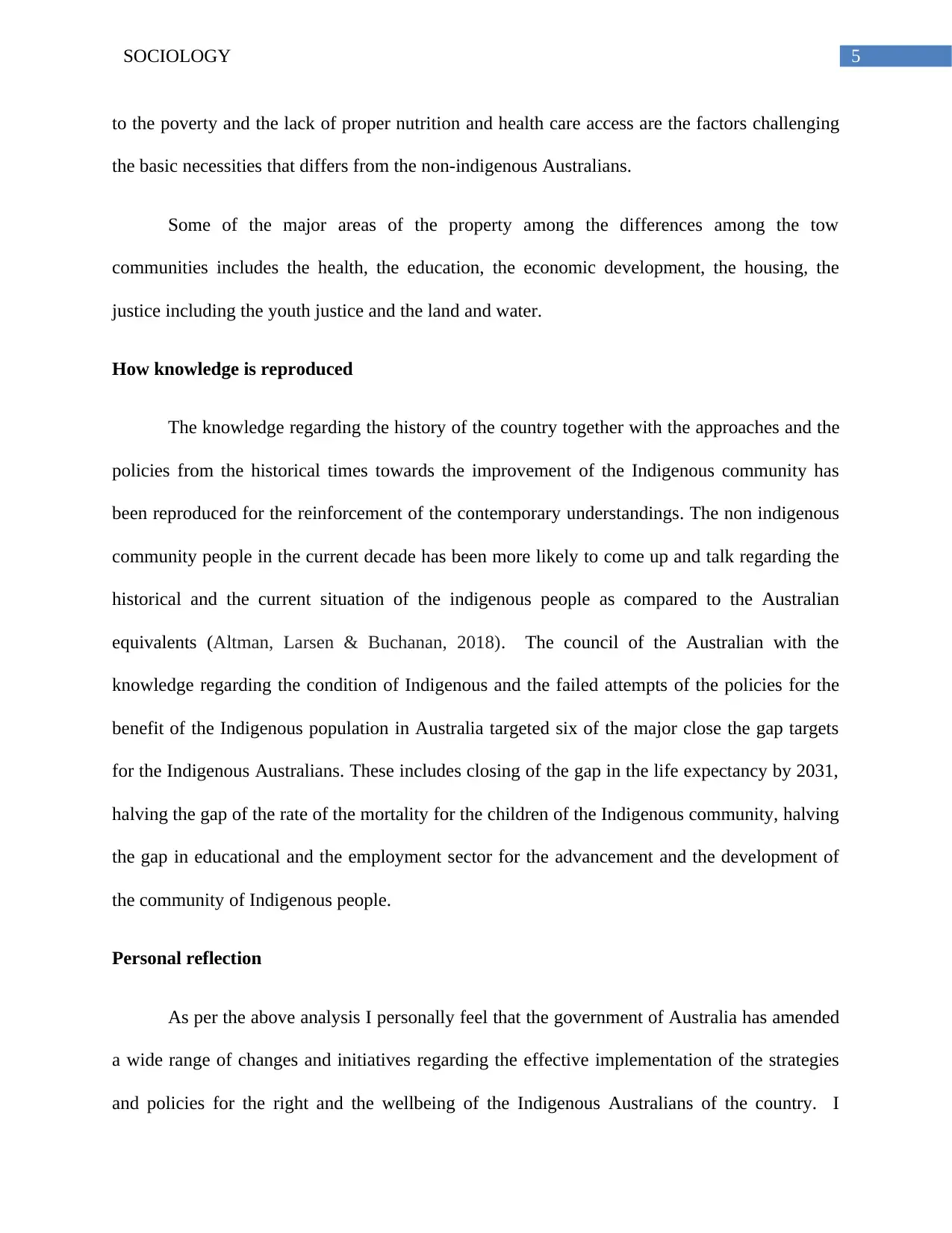
5SOCIOLOGY
to the poverty and the lack of proper nutrition and health care access are the factors challenging
the basic necessities that differs from the non-indigenous Australians.
Some of the major areas of the property among the differences among the tow
communities includes the health, the education, the economic development, the housing, the
justice including the youth justice and the land and water.
How knowledge is reproduced
The knowledge regarding the history of the country together with the approaches and the
policies from the historical times towards the improvement of the Indigenous community has
been reproduced for the reinforcement of the contemporary understandings. The non indigenous
community people in the current decade has been more likely to come up and talk regarding the
historical and the current situation of the indigenous people as compared to the Australian
equivalents (Altman, Larsen & Buchanan, 2018). The council of the Australian with the
knowledge regarding the condition of Indigenous and the failed attempts of the policies for the
benefit of the Indigenous population in Australia targeted six of the major close the gap targets
for the Indigenous Australians. These includes closing of the gap in the life expectancy by 2031,
halving the gap of the rate of the mortality for the children of the Indigenous community, halving
the gap in educational and the employment sector for the advancement and the development of
the community of Indigenous people.
Personal reflection
As per the above analysis I personally feel that the government of Australia has amended
a wide range of changes and initiatives regarding the effective implementation of the strategies
and policies for the right and the wellbeing of the Indigenous Australians of the country. I
to the poverty and the lack of proper nutrition and health care access are the factors challenging
the basic necessities that differs from the non-indigenous Australians.
Some of the major areas of the property among the differences among the tow
communities includes the health, the education, the economic development, the housing, the
justice including the youth justice and the land and water.
How knowledge is reproduced
The knowledge regarding the history of the country together with the approaches and the
policies from the historical times towards the improvement of the Indigenous community has
been reproduced for the reinforcement of the contemporary understandings. The non indigenous
community people in the current decade has been more likely to come up and talk regarding the
historical and the current situation of the indigenous people as compared to the Australian
equivalents (Altman, Larsen & Buchanan, 2018). The council of the Australian with the
knowledge regarding the condition of Indigenous and the failed attempts of the policies for the
benefit of the Indigenous population in Australia targeted six of the major close the gap targets
for the Indigenous Australians. These includes closing of the gap in the life expectancy by 2031,
halving the gap of the rate of the mortality for the children of the Indigenous community, halving
the gap in educational and the employment sector for the advancement and the development of
the community of Indigenous people.
Personal reflection
As per the above analysis I personally feel that the government of Australia has amended
a wide range of changes and initiatives regarding the effective implementation of the strategies
and policies for the right and the wellbeing of the Indigenous Australians of the country. I
⊘ This is a preview!⊘
Do you want full access?
Subscribe today to unlock all pages.

Trusted by 1+ million students worldwide
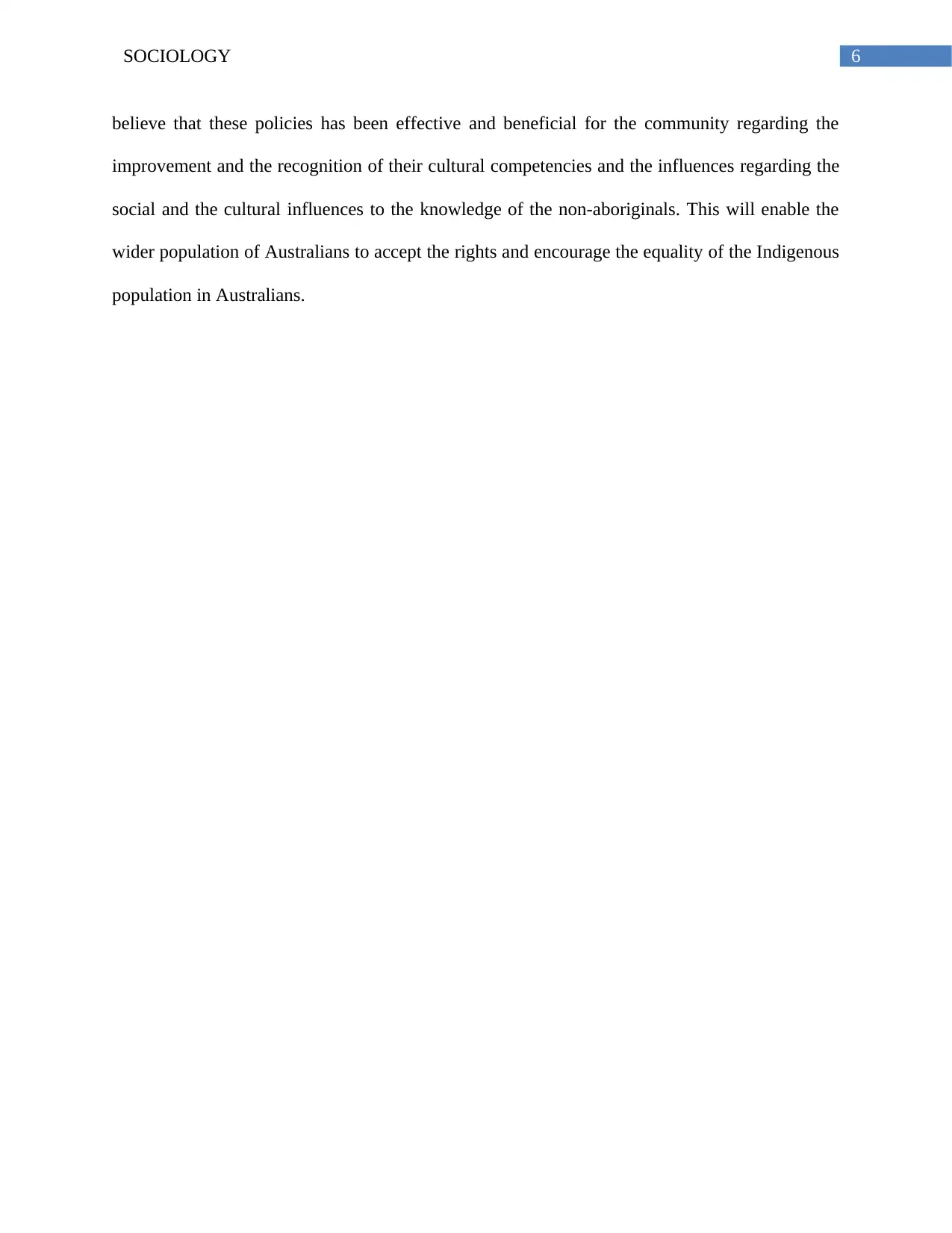
6SOCIOLOGY
believe that these policies has been effective and beneficial for the community regarding the
improvement and the recognition of their cultural competencies and the influences regarding the
social and the cultural influences to the knowledge of the non-aboriginals. This will enable the
wider population of Australians to accept the rights and encourage the equality of the Indigenous
population in Australians.
believe that these policies has been effective and beneficial for the community regarding the
improvement and the recognition of their cultural competencies and the influences regarding the
social and the cultural influences to the knowledge of the non-aboriginals. This will enable the
wider population of Australians to accept the rights and encourage the equality of the Indigenous
population in Australians.
Paraphrase This Document
Need a fresh take? Get an instant paraphrase of this document with our AI Paraphraser
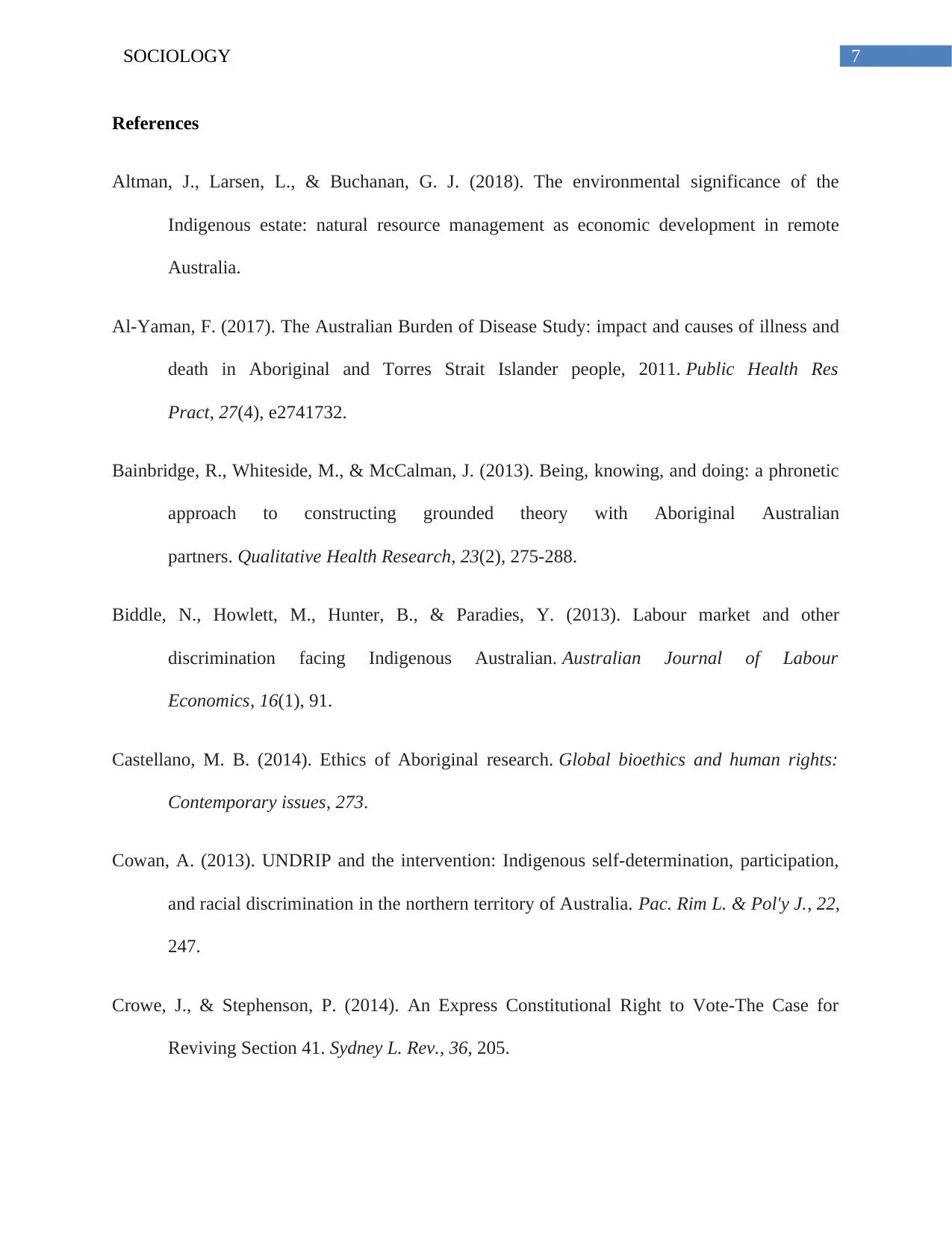
7SOCIOLOGY
References
Altman, J., Larsen, L., & Buchanan, G. J. (2018). The environmental significance of the
Indigenous estate: natural resource management as economic development in remote
Australia.
Al-Yaman, F. (2017). The Australian Burden of Disease Study: impact and causes of illness and
death in Aboriginal and Torres Strait Islander people, 2011. Public Health Res
Pract, 27(4), e2741732.
Bainbridge, R., Whiteside, M., & McCalman, J. (2013). Being, knowing, and doing: a phronetic
approach to constructing grounded theory with Aboriginal Australian
partners. Qualitative Health Research, 23(2), 275-288.
Biddle, N., Howlett, M., Hunter, B., & Paradies, Y. (2013). Labour market and other
discrimination facing Indigenous Australian. Australian Journal of Labour
Economics, 16(1), 91.
Castellano, M. B. (2014). Ethics of Aboriginal research. Global bioethics and human rights:
Contemporary issues, 273.
Cowan, A. (2013). UNDRIP and the intervention: Indigenous self-determination, participation,
and racial discrimination in the northern territory of Australia. Pac. Rim L. & Pol'y J., 22,
247.
Crowe, J., & Stephenson, P. (2014). An Express Constitutional Right to Vote-The Case for
Reviving Section 41. Sydney L. Rev., 36, 205.
References
Altman, J., Larsen, L., & Buchanan, G. J. (2018). The environmental significance of the
Indigenous estate: natural resource management as economic development in remote
Australia.
Al-Yaman, F. (2017). The Australian Burden of Disease Study: impact and causes of illness and
death in Aboriginal and Torres Strait Islander people, 2011. Public Health Res
Pract, 27(4), e2741732.
Bainbridge, R., Whiteside, M., & McCalman, J. (2013). Being, knowing, and doing: a phronetic
approach to constructing grounded theory with Aboriginal Australian
partners. Qualitative Health Research, 23(2), 275-288.
Biddle, N., Howlett, M., Hunter, B., & Paradies, Y. (2013). Labour market and other
discrimination facing Indigenous Australian. Australian Journal of Labour
Economics, 16(1), 91.
Castellano, M. B. (2014). Ethics of Aboriginal research. Global bioethics and human rights:
Contemporary issues, 273.
Cowan, A. (2013). UNDRIP and the intervention: Indigenous self-determination, participation,
and racial discrimination in the northern territory of Australia. Pac. Rim L. & Pol'y J., 22,
247.
Crowe, J., & Stephenson, P. (2014). An Express Constitutional Right to Vote-The Case for
Reviving Section 41. Sydney L. Rev., 36, 205.
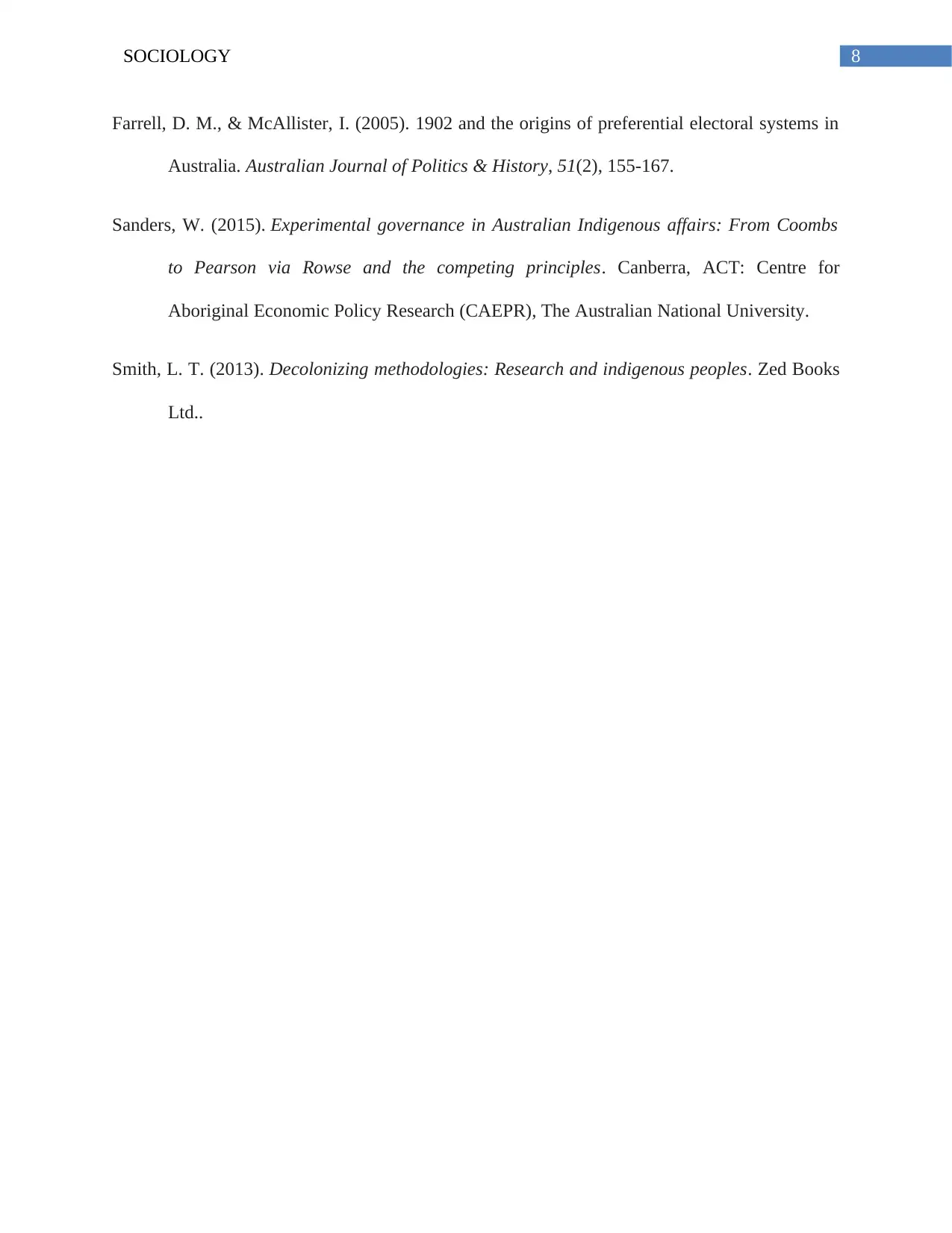
8SOCIOLOGY
Farrell, D. M., & McAllister, I. (2005). 1902 and the origins of preferential electoral systems in
Australia. Australian Journal of Politics & History, 51(2), 155-167.
Sanders, W. (2015). Experimental governance in Australian Indigenous affairs: From Coombs
to Pearson via Rowse and the competing principles. Canberra, ACT: Centre for
Aboriginal Economic Policy Research (CAEPR), The Australian National University.
Smith, L. T. (2013). Decolonizing methodologies: Research and indigenous peoples. Zed Books
Ltd..
Farrell, D. M., & McAllister, I. (2005). 1902 and the origins of preferential electoral systems in
Australia. Australian Journal of Politics & History, 51(2), 155-167.
Sanders, W. (2015). Experimental governance in Australian Indigenous affairs: From Coombs
to Pearson via Rowse and the competing principles. Canberra, ACT: Centre for
Aboriginal Economic Policy Research (CAEPR), The Australian National University.
Smith, L. T. (2013). Decolonizing methodologies: Research and indigenous peoples. Zed Books
Ltd..
⊘ This is a preview!⊘
Do you want full access?
Subscribe today to unlock all pages.

Trusted by 1+ million students worldwide
1 out of 9
Related Documents
Your All-in-One AI-Powered Toolkit for Academic Success.
+13062052269
info@desklib.com
Available 24*7 on WhatsApp / Email
![[object Object]](/_next/static/media/star-bottom.7253800d.svg)
Unlock your academic potential
Copyright © 2020–2025 A2Z Services. All Rights Reserved. Developed and managed by ZUCOL.





